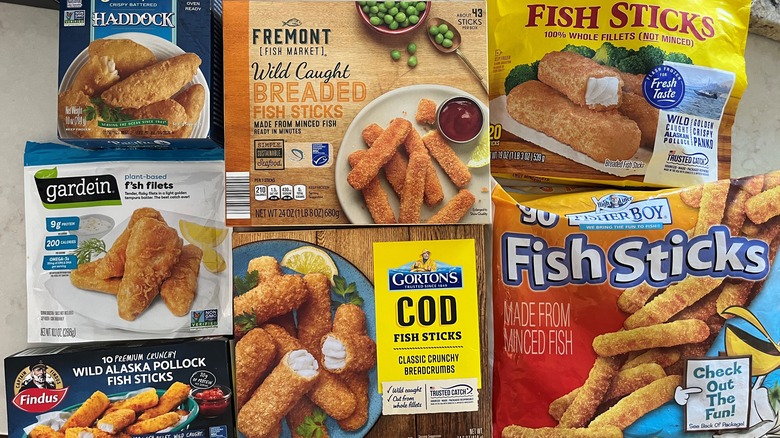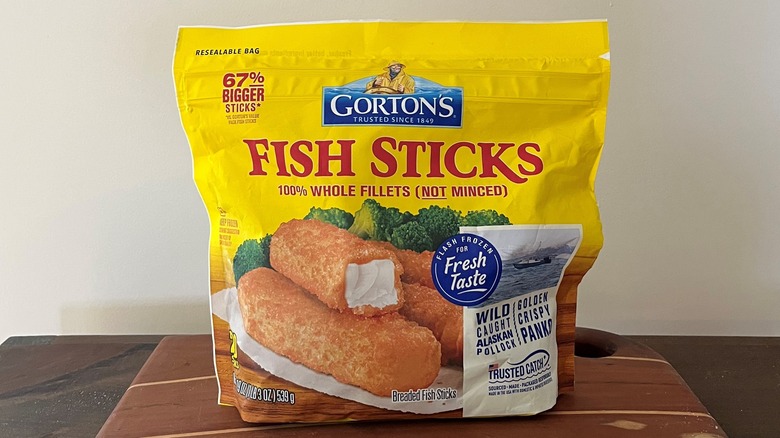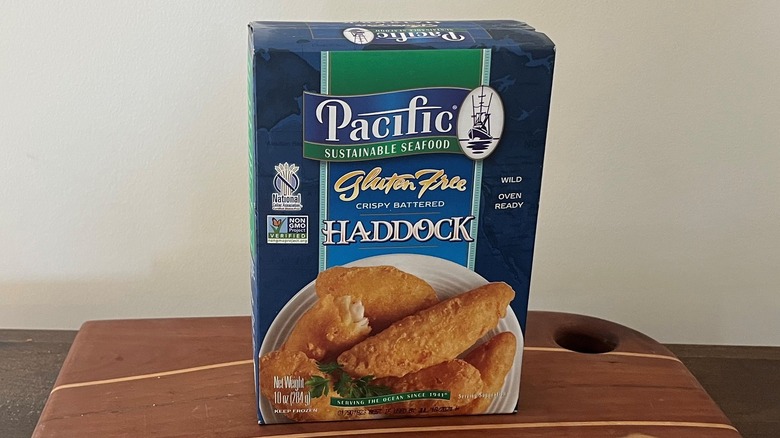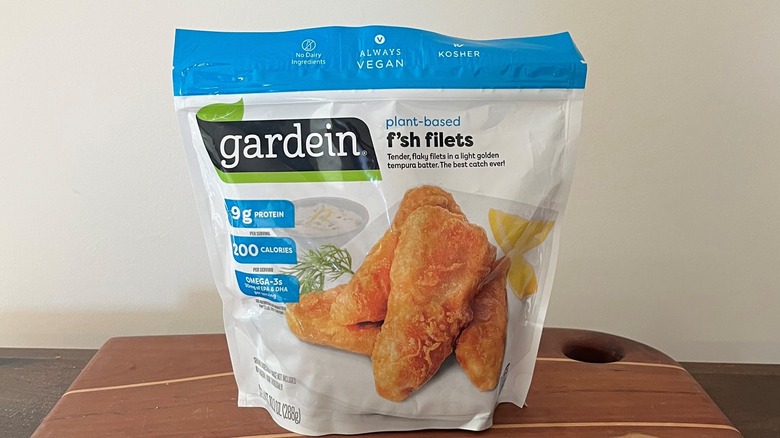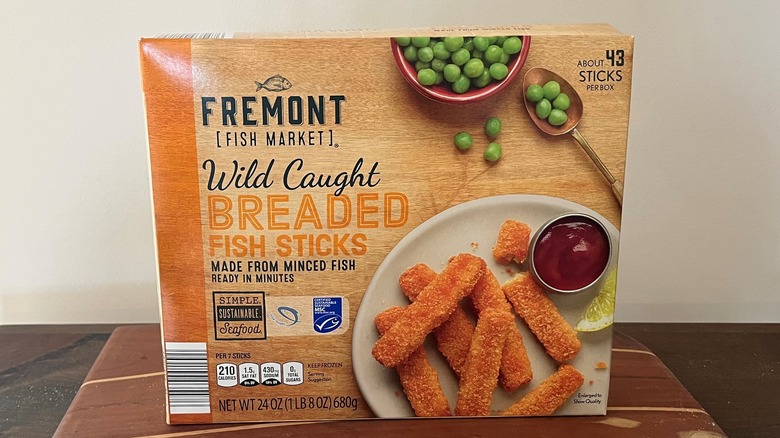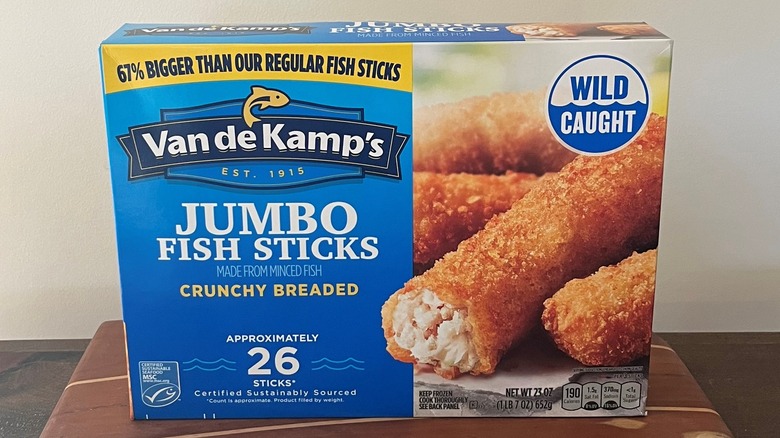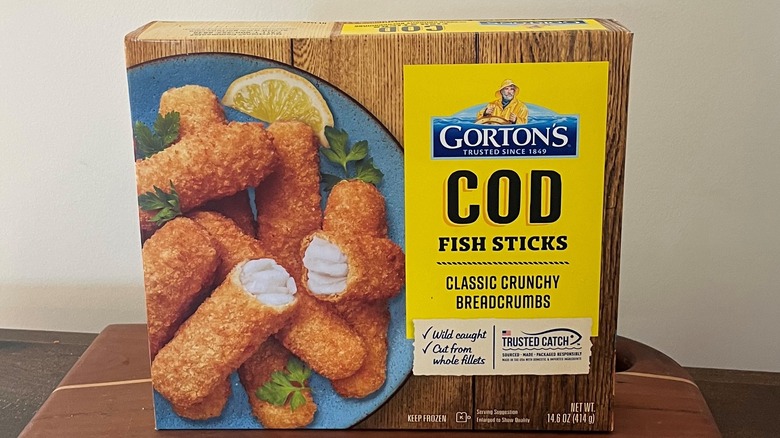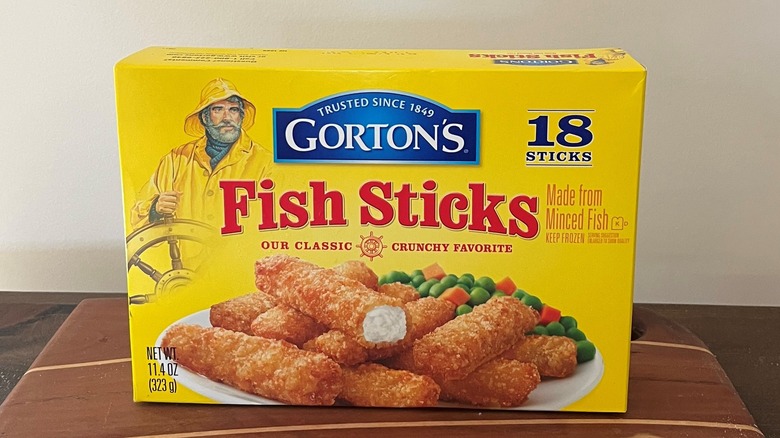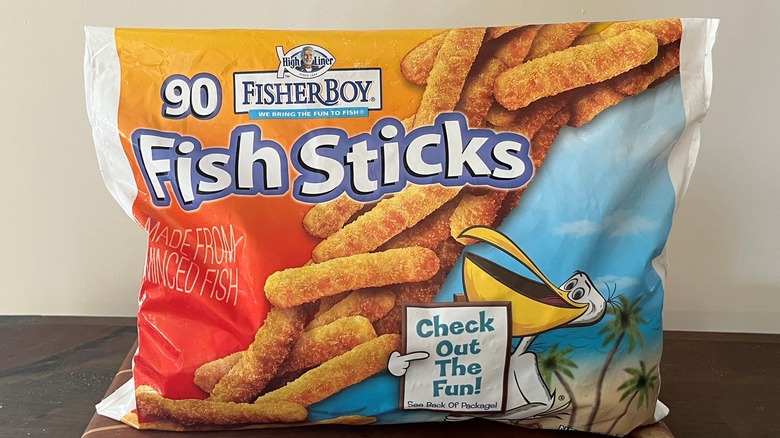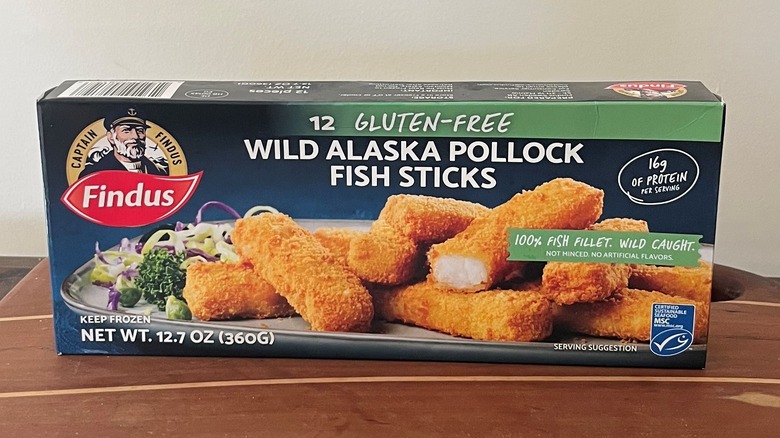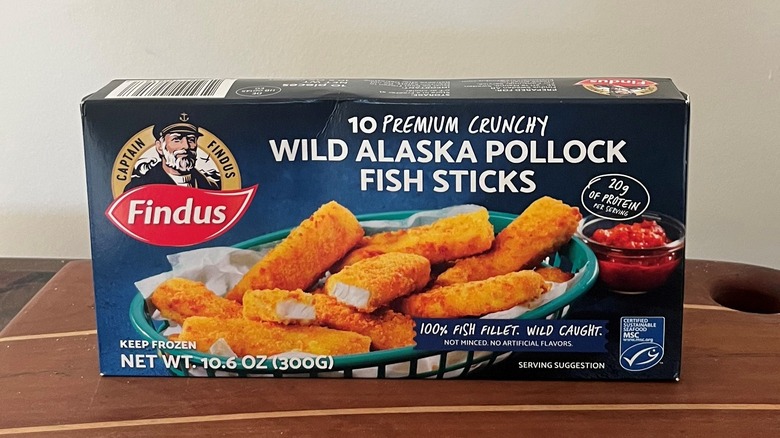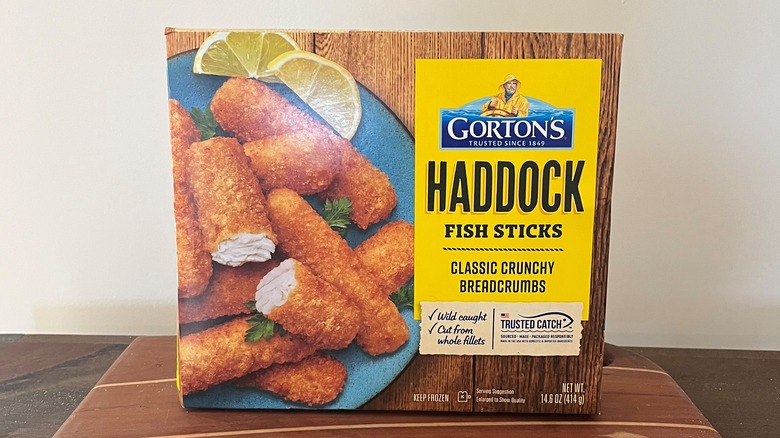Frozen Fish Sticks Ranked From Worst To Best
Did you grow up eating fish sticks? We did! Frozen fish sticks and frozen french fries were staples in our house and mom's oven-baked answer to fried fish and chips. Relatively cheap and easy to prepare, they are a timeless kid-friendly favorite.
Breaded, fried fish has been around practically forever, so it is hard to say with any certainty who invented the sticks. However, E. Robert Kinney gets the credit for introducing frozen fish sticks to the U.S. and making them popular. Kinney developed the product while working at Gorton's Seafood in the 1950s. At the time, fish was not very popular in America because it was hard to transport and store before it went bad. Frozen fish sticks solved both of those problems.
Gorton's was the first company to receive approval from the U.S. Department of Agriculture for a frozen food product, but many other companies quickly followed suit. We popped into two local grocery stores and tracked down 11 different varieties of fish sticks, including gluten-free and plant-based options. Some were better than others, although all were pretty tasty — it's hard to mess up breaded and deep-fried goodness. Here's how we ranked them, from worst to best.
11. Gorton's fish sticks 100% whole fillets
While we love other Gorton's products, we were disappointed by Gorton's fish sticks 100% whole fillets (not minced). With a mushy texture and a tendency to fall apart, these fish sticks are our least favorite of all the brands and varieties we sampled.
We suspect that this item is meant to be a little bit higher in quality than some of the other breaded fish options offered by Gorton's, hence the emphasis on the fact that they are made from whole fillets and not minced fish. But maybe minced fish just works better in fish sticks. We expect these to be finger foods, but finger foods don't work if they fall apart. We really needed a fork to eat these.
The nutritional profile here is similar to other frozen fish sticks from Gorton's. Each four-stick serving provides 10 grams of total fat, 20 milligrams of cholesterol, and 10 grams of protein.
10. Pacific Sustainable Seafood gluten-free crispy battered haddock
We were excited to find Pacific Sustainable Seafood's gluten-free crispy battered haddock, simply because finding gluten-free substitutes for breaded products such as fish sticks can be dicey. Unfortunately, this alternative failed to deliver in the texture and flavor departments, both of which are pretty important.
The breading here tastes just fine for breading made with corn and rice flour. However, it tends to fall off the fish, making it hard to eat. We also found the flavor to be very fishy. Of course, fish sticks should taste like fish, but the fish smell and flavor here are very strong in comparison to the other products we tried. Only buy these if you really love fish.
While we much prefer another brand's gluten-free version, we would still buy Pacific's product in a pinch for guests on a gluten-free diet. We visited multiple grocery stores when rounding up our selection, and each store only carried one brand of gluten-free fish sticks. If you have no other gluten-free options, Pacific Sustainable Seafood's crispy battered haddock will do.
9. Gardein plant-based F'sh filets
We are all about incorporating plant-based foods into our diet — we love a good veggie burger — but vegan seafood was not even on our radar before we came across Gardein's plant-based F'sh filets. The label caught our eye as we were scanning the aisles, and we thought, why not? It turns out the better question is, why?
Plant-based diets offer many health benefits, and providing a plant-based fish option allows fish lovers to get the best of both worlds. According to a 2023 study published in the European Heart Journal, people who follow vegan or vegetarian diets have lower levels of total cholesterol and fatty acids which are linked to heart attacks.
Unfortunately, Gardein's plant-based F'sh filets do not make a great fish substitute. The fish flavor is there, but the texture is all wrong. Fish sticks should be soft and flaky, but the "fish" (soy product) is chewy. Sometimes, it is better to just eat something else than to pretend the substitute is anything like the real thing. There are many superior vegetarian foods out there that we prefer to these fake fish sticks.
8. Fremont [Fish Market] wild caught breaded fish sticks
Unless you are an Aldi shopper, you might not be familiar with the Fremont [Fish Market] brand of frozen seafood products. Aldi junkies everywhere will recognize these frozen fish sticks as the in-house brand of the discount grocery chain. If you shop at Aldi, you probably have no other choice, which is fine. While Fremont [Fish Market] wild caught breaded fish sticks are not our favorite, they get the job done.
These frozen sticks are smaller and skinnier than average. The breading has a nice brown color and a crispy texture, but overall it is pretty oily. We baked ours on parchment paper and they left a very greasy residue, far more than the other ones we made. But if you are not particular about grease, these are just fine.
We noted that the nutritional profiles of frozen fish sticks are pretty much the same between all the varieties, but Fremont's are actually a little bit lower in fat than the other ones we tried. Each five-count serving provides 6 grams of total fat, 20 milligrams of cholesterol, and 7 grams of protein.
7. Van de Kamp's jumbo fish sticks
Van de Kamp's jumbo fish sticks really are jumbo and almost double the size of some of the other ones we sampled. The large size means that each unit has more fish and less breading. Van de Kamp's panko breading provides just the right amount of crispiness per bite and really stood out among the pack. The fish is minced, which we like because it seems to keep the breading from falling off.
The label claims that these are made with wild-caught pollock, which may provide more health benefits than farm-raised fish. According to Colorado State University, fish caught in the wild tend to contain less saturated fat, presumably because they feed on a more natural and varied diet. Wild-caught fish also have lower levels of contaminants and are less likely to be diseased than farm-raised fish. In general, wild-caught fish are more expensive than farm-raised, but frozen options like fish sticks are a budget-friendly way to reap the benefits.
Van de Kamp's jumbo fish sticks have a similar nutritional content to the other products we tried. One serving, which consists of three fish sticks, provides 8 grams of total fat, 30 milligrams of cholesterol, and 8 grams of protein.
6. Gorton's cod fish sticks
Gorton's offers a large selection of frozen fish sticks, which is no surprise when considering that this company originated the product. We tried Gorton's cod fish sticks and liked them just fine, although they are not our favorite.
These frozen fish sticks are bigger than we expected. Although they are not labeled as jumbo, they seem just about the same size as the jumbo ones from Van de Kamp's. The breading has a nice color and tastes good, but it cracks easily, which makes these messy to eat. Still, the flavor is light and not overly fishy, and the nutritional profile is comparable to the other options. A single serving provides 10 grams of total fat, 15 milligrams of cholesterol, and 8 grams of protein.
According to Healthline, both Atlantic and Pacific cod are good sources of several B vitamins, including vitamins B12, B6, and niacin, as well as phosphorus and selenium. As a bonus, unlike some other types of fish, cod is low in mercury.
5. Gorton's fish sticks (minced)
We ranked Gorton's fish sticks made from minced fish just slightly higher than Fisher Boy's product, but they actually taste pretty similar. Gorton's fish sticks are small and thin with a nice breading-to-fish ratio and a crispy, crunchy texture. The darker color is in line with what we expect to see from freshly fried, breaded fish.
The nutritional profile is pretty similar to the other fish sticks in our list: 9 grams of total fat, 15 milligrams of cholesterol, and 9 grams of protein in each four-stick serving. The label highlights that this is a good source of natural omega-3 fatty acids, which the Mayo Clinic reports reduce inflammation throughout the body. Eating fish twice a week is a good way to reap these health benefits. The label also indicates that these fish sticks are kosher and contain dairy. If you're wondering about the latter, it turns out the breadcrumb coating contains whey.
4. Fisher Boy fish sticks
Of all the fish sticks we sampled, Fisher Boy's had the most "bargain" look about them: giant plastic bag, goofy logo, "made from minced fish" in all caps. When we opened the bag, we found the fish sticks themselves to be pretty small, so we weren't expecting much. We were pleasantly surprised when we took a bite and found them to be pretty tasty.
These fish sticks are small and skinny, which gives them a crispy, crunchy texture that is very satisfying to chomp down on. The breading-to-fish ratio is high, making these a great choice for people who enjoy the crunch more than the fish, or for parents trying to subtly introduce fish into their children's diets.
Taste-wise, Fisher Boy's product holds its own against what we tried from other brands. Nutritionally, these are pretty similar to others out there. One four-stick serving provides 12 grams of total fat, 15 milligrams of cholesterol, and 12 grams of protein. Unlike other fish sticks, Fisher Boy's are a decent source of iron, with each serving providing 1.7 milligrams or 10% of the recommended daily value.
3. Findus Wild Alaska pollock fish sticks gluten free
We have tested a lot of gluten-free products over the years, and Findus' fish sticks are one of the better items around. Some gluten-free foods are just off — they might have a gritty texture, leave a funny aftertaste, or simply taste so unlike the regular version that they are really a different product, not a comparable substitute. But Findus Wild Alaska pollock fish sticks tasted almost exactly like the gluten-containing version, which is welcome news to anyone avoiding gluten.
The breading contains a mix of rice flour, gram flour, potato starch, corn starch, potato flakes, pea fiber, and pea starch. The result tastes good, has the right texture, and looks like the breading on other fish sticks. In fact, these gluten-free fish sticks look exactly like the gluten-containing version from Findus, so be careful if you're baking both at the same time.
2. Findus Wild Alaska pollock fish sticks
Findus is a new brand to us, and we were pleasantly surprised with the high quality of its Wild Alaska pollock fish sticks. Before we baked them, we noticed that they are strikingly consistent in size, shape, and breading coverage. Every stick looks exactly the same, which is not the case with every brand we tried. That quality control extends to the spot-on flavor and the texture, which was soft without being the slightest bit soggy.
According to the National Oceanic and Atmospheric Administration (NOAA), wild-caught Alaska pollock is a sustainable choice for seafood consumers. The fish stocks around Alaska have not been overfished, and fishermen's trawling methods have minimal impact on the habitat. In addition, pollock fishing has a low rate of incidental catch, so other species are spared. Each five-stick serving of Findus Wild Alaska pollock provides 12 grams of total fat, no cholesterol, and 20 grams of protein.
1. Gorton's haddock fish sticks
It's no surprise that Gorton's fish sticks come in at the top of our list. After all, this company has been making frozen fish sticks longer than anyone else. Gorton's offers multiple varieties and we tried more than one — but our favorite is haddock. These fish sticks have a different flavor, probably because they are one of the few that use haddock.
These have just the right balance between fish and breading, resulting in a deliciously crispy texture. They are also bigger in size than some of the other brands, which means more fish. Basically, Gorton's haddock fish sticks are the role model for all other products.
Unfortunately for haddock lovers and New England fishermen, the New England Fishery Management Council recently lowered the catch limits in an effort to reduce overfishing (via Associated Press). However, the American haddock supply should not be drastically affected because many seafood packaging companies import haddock.
Like most foods that are breaded and fried, Gorton's haddock fish sticks are a little bit high in fat. One serving, which consists of three sticks, provides 10 grams of fat, which is 13% of the recommended daily value. It also provides 15 milligrams of cholesterol and 8 grams of protein. However, most importantly, this product offers the perfect combination of crispy and flakiness that we love in a fish stick.
